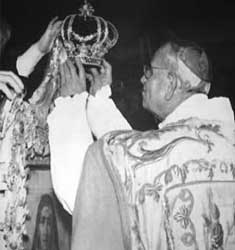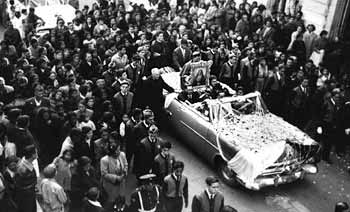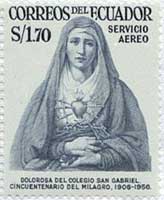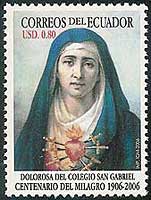|
Newsletter of the District
of Asia
October
2007 - March 2008
Our
Lady of Quito Queen of Ecuador
1906 – 2006
(First
English translation, by Fr. Paul Kimball, SSPX, of
La
Dolorosa de Quito, Reina del Ecuador,
with
authorization of the publisher, Libreria Espiritual, Quito)
PART
THREE
The
Veneration of Our Lady of Quito
Veneration
of Our Lady of Quito, which is more properly called the Sorrowful
Heart of Mary (and so it is entitled within the movement directed
to her Heart advanced by herself in the last times),[1]
began immediately. On Sunday June 3, 1906, a great procession
was already made, with more than 10,000 people attending besides
some 35,000 spectators.

On
July 2 the first great Novena of Our Lady of Quito began, which
is repeated every year on April 11 so as to finish on the eve
of the festive anniversary of the miracle, and has always gone
on growing in fervor. Not content with the annual novena, the
practice was established, in Quito and in other cities, of celebrating
special devotions in honor of Our Lady of Quito on the 20th
day of each month. And also in 1932 the Bulletin of Our Lady
of Quito was founded, a monthly publication to propagate the
devotion to her.
Particularly
noteworthy were the honors given to Our Lady of Quito in 1931,
the silver anniversary of the miracle, which shook the entire
nation; and the first Ecuadorian Marian Congress was held. The
chronicles of the celebration fill four volumes. In 1934 the picture
went on pilgrimage to Riobamba and other cities for the first
time, generating unusual enthusiasm and tremendous excitement.
The pilgrimages have been repeated. Another pilgrimage was made
to Riobamba in 1938, then to Guayaquil, and to the north, to Pasto
(Columbia). In 1947 the picture went to Cuenca where it remained
a whole month.
In
1956, the golden anniversary of the miracle, there was a Canonical
Coronation of Our Lady of Quito. Pope Pius XII in the Brief of
the Coronation said: “Having consulted the Sacred Congregation
of Rites, we grant by our apostolic authority and in virtue of
this brief to our beloved son, Carl María de la Torre, Cardinal
Priest of the Holy Church, Archbishop of Quito, that he impose
in our name and with our authority, a Crown of gold upon the image
of the Most Holy Virgin, the Sorrowful Mother of the College,
AS QUEEN OF THE CATHOLIC EDUCATION IN ECUADOR.” Dr. Camillus Ponce
Enríquez, President of the Republic,[2] thanked God
and Our Lady of Quito, in front of 40 diplomatic delegations,
for his electoral victory.

In
1956 the golden anniversary of the miracle, there was a Canonical
Coronation
by Carl Maria de la Torre on behalf of Pope Pius XII
1958. The relocation of the College of St. Gabriel to a new building
was made. With the College the Picture of Our Lady of Quito will
also be moved.
1978.
On December 30 the National Shrine of the Sorrowful Mother is
blessed and dedicated.
1981.
This year marked the diamond anniversary of the miracle. In these
seventy-five years, churches dedicated to our Queen and Mother
have been built such as in Riobamba, Cotacachi and Ibarra. Colleges
have been founded as in Loja and schools as in Llano Grande with
her name. In other cities and parishes Congregations function
in her honor as in Otavalo, to beg for the children and for the
Ecuadorian youth.
“Once
again the miraculous picture is traveling throughout the whole
Republic, in towns, hospitals... The enormous interest and national
fervor is impressive. Since the month of February, a program dedicated
to the jubilee is transmitted daily by 46 radio transmitters and
by television on Saturdays. Novenas, rosaries at dawn, and popular
missions in preparation for the arrival of the Virgin take place,
which increase the number of confessions and communions, with
solemn Masses, in the stadiums, because the churches become too
small.
One
sign of the national response is the resolution of the Very Illustrious
City of Ante. “Considering that it is the duty of the City to
exteriorize the religious and Marian sentiment of the people that
it represents, it is resolved:
- To render
homage of admiration and honor to the Sorrowful Mother of the
College on the diamond anniversary of the miracle of the tears
shed for the country.
-
To give the keys of the city as a symbol of respect and admiration
to the Queen of Heaven.
-
To
recommend to all the Christian people, and particularly to the
youth, devotion and love to the Sorrowful Mother of the College.
- To be officially
present as a group at the solemn act of her reception.”

Favors
of Our Lady of Quito
Our
Mother is she who always begins to give us things, and to love
us. “God hath first loved us” (I Jn. 4, 10), but when we come
to Her, then she does her utmost, even with miracles. There would
be no end in recounting all her gifts and favors. The vast majority
we will know only in heaven. We are going to listen to some accounts.[3]
- In the year
1917, in Ecuador, a young woman, Rose Ponce Ribadeneira was going
with a group of people from Hacienda Capelo, in Sangolquí, to
Santa Rosa, from the property of Mr. Jijón, when the horse on
which she was riding slipped and fell to the ground, she remaining
tangled in the stirrup. The horse was startled and bolted out
of control, dragging along the body of the unfortunate young woman,
amidst the screams of terror that the onlookers were making. One
of them, Dr. Belisario Ponce, went quickly in pursuit inwardly
convinced that he was not going to retrieve anything but the body
of his niece in pieces; but what was his surprise when going around
a curve, he noticed from afar a black shape rising up from the
ground, he recognized that that it was his niece and he rushed
towards her, who, as though she were insane, was muttering these
words: “The Virgin has saved me. At the time I mounted I commended
myself to the Sorrowful Mother of the College, and the whole way
I was dragged I did not cease to cry out to the Sorrowful Mother.
She has saved me.” The horse ran a distance of about three hundred
yards from the place where it bolted to where the dragging ended,
due to the fact that the girth came off and the saddle fell to
the ground; and apart from Rose having her face completely covered
with dirt and her clothes in tatters, she showed absolutely no
sign of the dragging. She had no wounds, not even on her face
or her head.
- In 1927
a boy, Oswald Romero, was run over by the main part of a wagon
full of rocks. When falling he remembered the Mother of Sorrows.
That day, after fainting and vomiting blood, he stayed asleep
and afterwards was healed without medicine. He later became a
priest in the United States.
- In England,
where she is known under the name of “Our Lady of Quito,” her
devotion grew greatly due to the innumerable favors that she worked
during the World War, saving the houses that had her image, from
the damage produced by the aerial bombardment. Even the Protestants
themselves placed an image of the Sorrowful Mother in their houses
and churches. Soldiers, marines and airmen carried with them small
pictures so as to feel her maternal protection. Deeds such as
the ones we transcribe below repeat themselves at each step.
- An officer
wrote to his wife, “I have just narrowly escaped death by a real
miracle in North Africa. I was crossing our lines in my car in
full battle. I had to travel some two miles on the open highway.
A car in these circumstances is an easy target for the enemy air
force. Indeed, soon after, out of some low clouds four aircraft
emerged that immediately began to pursue me. They came flying
at a low height behind me. At once I felt engulfed by a rain of
artillery fire and machinegun fire. Suddenly, as the first result
of the attack, a howitzer shell pierced the back part of the car,
and after tearing my shirtsleeve and grazing my arm just below
the shoulder, smashed the windshield and went on to kill a poor
man who was trying to take refuge in a hole, about a hundred yards
ahead. Another bullet pierced my cap, and a third snatched away
from me my binoculars from my back. An artillery shot demolished
one of the doors of the car, and finally it went into the ditch,
pierced by six shots of artillery and riddled by gunshots; it
stayed there like a sieve, but the driver and I were unhurt. Truly
God has been good to me. Tell my mother that I was carrying the
picture of Our Lady the Sorrow Mother of Quito in my pocket.
- She is also
known in Australia, where many hundreds of small pictures of the
Sorrowful Mother of Quito have been distributed. There they have
felt, just as in Ecuador, the compassionate hand of this Blessed
Mother in the multitude of favors, such as the following, which
occurred in Melbourne in 1948. A little girl fell from a balcony
onto a cement floor. Having been taken to the hospital, her condition
became serious. The father and mother of the girl prayed before
the image of the Sorrowful Mother of Quito. She heard their prayers
and in a short time the girl was completely cured.
- And Mr.
Ripalda likewise tells of a favor of the Virgin: “A contract with
the Government of several million sucres[4] obliged
me to rent an airplane from Ateca, in order to bring to Quito
the commodity that had arrived from Guayaquil. Although it seemed
imprudent to me to undertake the flight after six o’clock in the
afternoon, because of the insistence of my friends I had to yield.
When I crossed the mountains I saw that there was a torrential
rain, which disturbed me; but my uneasiness was greater when I
was informed in the cabin that the motors were failing and we
were in serious danger. In order to save the plane, we thought
of throwing the cargo to the ground, but the door did not open.
I was thinking about the crash of the plane and about the ensuing
death. Amidst the shadows of my distress, I placidly remembered
the Sorrowful Mother of the College, to whom with the faith of
a child I began to pray the Hail Holy Queen. Shortly after, a
there was a tremendous jolt of the plane followed by groans of
sorrow and cries of despair. I did not cease to beg the help of
the Virgin, in the midst of the most complete darkness. I looked
for the exit door, which gave way easily. This was the first miracle
that I attributed to the Sorrowful Mother. But I believe I saw
a deep abyss at my feet. Again I began to cry out to the Sorrowful
Mother for help and protection. An immense wave entered into
the plane, without me getting submerged within it. The plane had
plunged into the Guayas River and was sinking slowly. I jumped
into the water fully clothed, even wearing my hat. I thought that
I was in the sea. A small boat that was providentially passing
by the place of the accident saved me. By my directions the other
passengers, although injured, were also rescued. The pilot and
the manager of Ateca lost their lives. Days later, I thanked the
Sorrowful Mother for this favor. Starting today,” I said, “I believe
in the Catholic religion, I believe in miracles; I would like
to do something for the Sorrowful Mother in the material order;
I would like above all to be henceforth a practicing Catholic.
I promise to confess and receive Communion.”
Postage
Stamps of Ecuador printed for the 50th and 100th anniversaries
of the miracle
· Better known, by the public narrations
of the protagonist himself, was the following: on Thursday June
5, 1941 the North American Captain Burguess and the Ecuadorian
officials Second Lieutenant Dávalos and Lieutenant Louis Arias
departed from Esmeraldas for Salinas. This last man, even after
very many years, remembers with all the details the tragedy while
the students listen with growing emotion: “I asked the captain
if they had loaded the gasoline. He assured me that even the auxiliary
tanks had been filled. With this certainty I began the flight.
It was four o’clock in the afternoon; we went into a storm so
thick that the ends of the wings could not be seen. The motor
started to stall. My fear was realized: there was no gasoline!
“Beneath my feet was the sea. The plane shook indecisively; it
began to descend slowly, irremediably… I heard a hiss, a screech,
a bang… We slid open the laminated windows, we took off our clothes,
and put on the life jackets. The water was flooding the cabins,
and so we had to abandon the plane. I found myself in the depths
of the sea, surrounded by sharks and with my companions hanging
on me because they did not know how to swim. The captain was driven
insane out of terror, and he died at about ten o’clock. We both
were perhaps hoping for the same thing.
“A splendid day dawned and it enabled me to realize that the coast
was within sight. We swam with all our strength. Dávalos began
to despair; finally he was silent; then, a gasp… He was dead!
I clung with anxiety to the corpse. No one can imagine how useful
the company of a human being is, even if it be a corpse.
“I continued like this. It was getting dark. I still kept up my
morale, but my strength was diminishing. The sharks were hounding
ahead threatening the corpse. Very soon a strong tug pulled us
down… I could do no more… I let go of the corpse. I swam desperately;
I was getting weak.
“But suddenly, as if to make my agony less painful, the picture
of the Sorrowful Mother came to mind, the picture of the Virgin
whom I loved so much in the College. And in the midst of the confusion
I besought her; I begged God that He would not let me perish if
I could still serve Him. I thought of my mother, of my brothers,
and I turned to that which gives strength to a man: the faith.
“I found myself finally about 400 yards from the cliff of the
coast. The undercurrent was pulling me, and after six hours of
efforts, I did not succeed to get to the shore. One gigantic wave
that carried me on its crest was going to break upon it. I felt
that my feet were touching something; it was a rock. I grabbed
on to it and left the water. My body exhausted, mangled, scorched,
I did not resist any more: I fell down dismayed.
“Then another day dawned. A splash of water restored me to my
senses, and I despaired. I could do no more. For a moment I was
overcome by desperation. I reacted. I looked around and saw a
fisherman. I wanted to shout, but my voice would not come out.
The fisherman being suspicious was looking at me like a monster
or a lunatic: naked, staggering, and desperate. Finally he came
near. Another fisherman appeared. I was saved, thanks to the Sorrowful
Mother of the College.
“Now in Quito, my only concern was to publish the miracle in which
the Sorrowful Mother wished to make it evident that we have in
her a true Mother.”
Footnotes
[1]
See the booklet: Fatima. El Corazón de María, especially pp. 24
and following.
[2]
He was the first conservative candidate elected to the presidency
after 64 years of liberal government. He had studied in the College
of St. Gabriel for his high school studies and was president of
the Republic of Ecuador from 1956-1960.
[3]
God wishes that His “feats” or extraordinary interventions be
told (Cf. Is. 12; Ps. 9, 77, 85, 104, 117, 144 etc.) and this
is an act of worship. There is no room for doubt that, like a
good sermon, it makes an impression upon the faithful, it helps
them to be better, and to go to God. That “superior” attitude
that “disregards” miracles, by making them seem related to one’s
inadequate education, is part of the global strategy of the prince
of this world to hunt down such nuisances: by disparaging all
that which is traditional, “gratifying the ears with novelties,”
and desecrating and pernicious novelties at that, without Confession
or Eucharistic life, nor penances, nor miracles, not consequently
asking them from God.
[4]
The currency of Ecuador was formerly in sucres.
Note:
The three parts of the story of La Dolorosa de Quito which appeared
in this Newsletter are now available in booklet form from the
Asian District Office for USD $3, inclusive of postage.
contents
|


![]()
![]()




